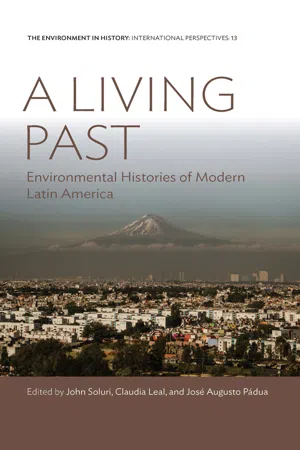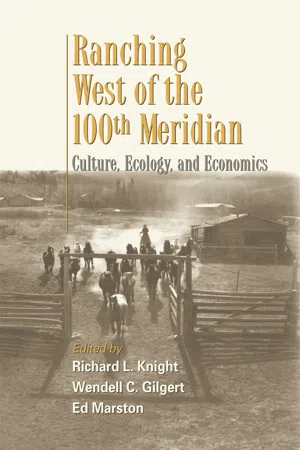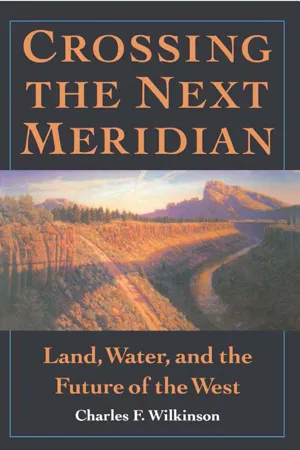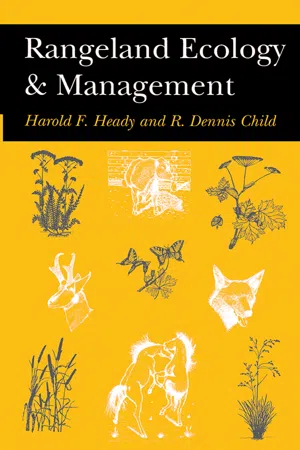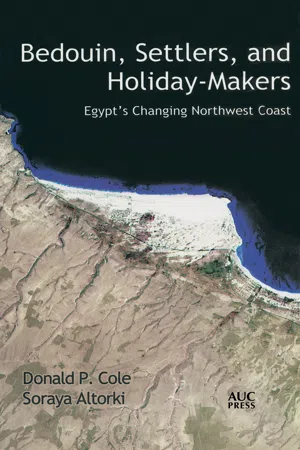Geography
Ranching
Ranching is a form of agriculture focused on raising livestock, typically cattle, on large open land areas known as ranches. It is commonly associated with the American West and other regions with extensive grasslands. Ranching involves managing the animals, maintaining the land, and often includes activities such as herding, branding, and caring for the livestock.
Written by Perlego with AI-assistance
Related key terms
Related key terms
1 of 4
Related key terms
1 of 3
6 Key excerpts on "Ranching"
- eBook - ePub
A Living Past
Environmental Histories of Modern Latin America
- John Soluri, Claudia Leal, José Augusto Pádua, John Soluri, Claudia Leal, José-Augusto Pádua(Authors)
- 2018(Publication Date)
- Berghahn Books(Publisher)
Similarly, where drainage and irrigation projects were impractical, cattle’s mobility enabled stockowners to adapt to climatic fluctuations and lower the risks typically associated with agricultural production. Comparatively easy to manage from a distance, Ranching also enjoyed economies of scale that crop farming typically did not until the diffusion of farm machinery. Where access to credit remained limited, the relative liquidity of livestock made them a desirable investment and a way for ranchers to tap domestic capital. In fact, before postwar industrialization and economic expansion generated more investment options, considerable amounts of Latin American capital were tied up in cattle and grass. In some rural areas today, Ranching remains one of the few viable ventures. While the profits may have been modest, they tended to be secure. Over the long run, ranchers could also profit from rising land values as frontier regions became integrated into the national economy. Jesse Knight, who speculated in land in Colombia during the 1940s and 1950s, stated that raising cattle was “one of the best means I know of to show dominion and the exercise of possession over one’s property.” 57 It is a mistake to believe, however, that “land, not profits from beef production” motivated ranchers. 58 The economic viability of Ranching (and the display of mobile capital) made its other attributes possible, not vice versa. Susanna Hecht has shown how the incentives offered by the Brazilian government to settle the Amazon created a speculative bubble in which rapidly rising land prices made the operating costs of Ranching an afterthought despite the fact that “pastureland created from forests is expensive to implant and to maintain.” 59 This situation was atypical in the larger history of Ranching - eBook - ePub
Ranching West of the 100th Meridian
Culture, Ecology, and Economics
- Richard L. Knight, Wendell Gilgert, Ed Marston, Richard L. Knight, Wendell Gilgert, Ed Marston(Authors)
- 2012(Publication Date)
- Island Press(Publisher)
23 Rather than lark buntings and bobcats, we will have starlings and striped skunks. Rather than rattlesnakes and warblers, we will have garter snakes and robins. Is that the West we want? It will be the West we get if we do not slow down, get to know the human and natural histories of our region better, and then act to conserve them.Ranching: THE VIEW FROM HERE
The West is a region of diverse ecosystems, cultures, and economies. Ranching as a land use, and ranchers as a culture, have been with us for more than four hundred years, dating back to the early Spanish colonists who struggled northward over El Paso del Norte and found a home for their livestock near present-day Espanola, New Mexico. Today, more so than at any time in its history, the Ranching culture is under assault. If what I have presented in this essay is true—that ranch lands are compatible with our region’s natural heritage and that herbivory is a necessary ecological process in the restoration and maintenance of healthy rangelands—then why are ranchers and livestock grazing so vilified? Why have scores of environmental groups banded together for “a prompt end to public lands grazing”?24Could it be a difference in values? I began this essay by reporting how a conservation biologist wrote a review of livestock grazing that universally condemned it as a land use incompatible with biodiversity. In trying to understand how his review differed from what other scientists have reported, ranging from the National Academy of Sciences to noted plant ecologists, I began to wonder if it was just a difference in values. Might some westerners want the public and private lands free of manure, cows, sheep, and fences because they want them for their own uses—such as mountain biking and river rafting? Do some want ranchers and their livestock off the western ranges because they believe what others have told them—that cows and sheep sandblast land and that cattle barons are arrogant bastards intolerant of any but their own kind? Certainly differing values and distorted mythology can obscure facts; at the end of the day, emotion may trump judgment. Would it make any difference if we found that ranchers are stewards of the land, that cows are being used as a tool in the recovery of arid ecosystems, that open space, biodiversity, and county coffers are enriched more from Ranching than from the rapidly eclipsing alternative, ranchettes? Perhaps. - eBook - ePub
Crossing the Next Meridian
Land, Water, and the Future of the West
- Charles F. Wilkinson(Author)
- 2013(Publication Date)
- Island Press(Publisher)
23The Costs of Overgrazing: Adjustments to the Rancher’s Code
By the mid-1880s, cattlemen controlled the land they needed, but the ground and the vegetation were absorbing a terrible beating. In 1886, Theodore Roosevelt, who later would make his mark on grazing and other resource policy as president, traveled through the plains country. He wrote of the life of the cowboy and the “free grass” offered up by the United States. He also issued this warning:But scantiness of food, due to overstocking, is the one really great danger to us in the [northern Great Plains], who do not have to fear the droughts that occasionally devastate portions of the southern ranges. In a fairly good country, if the feed is plenty, the natural increase of a herd is sure shortly to repair any damage that may be done by an unusually severe winter—unless, indeed, the latter should be one such as occurs but two or three times in a century. When, however, the grass becomes cropped down, then the loss in even an ordinary year is heavy among the weaker animals, and if the winter is at all severe it becomes simply appalling. The snow covers the shorter grass much quicker, and even when there is enough, the cattle, weak and unfit to travel around, have to work hard to get it; their exertions tending to enfeeble them and to render them less able to cope with the exposure and cold.... The cows in calf are those that suffer most, and so heavy is the loss among these and so light the calf crop that it is yet an open question whether our northern ranges are as a whole fitted for breeding. When the animals get weak they will huddle into some nook or corner and simply stay there till they die.... - eBook - ePub
- Harold Heady(Author)
- 2019(Publication Date)
- Routledge(Publisher)
Rangeland is a type of land that supports different vegetation types including shrublands such as deserts and chaparral, grasslands, steppes, woodlands, temporarily treeless areas in forests, and wherever dry, sandy, rocky, saline, or wet soils, and steep topography preclude the growing of commercial farm and timber crops. Rangeland vegetation may be naturally stable or temporarily derived from other types of vegetation, especially following fire, timber harvest, brush clearing, or abandonment from cultivation. Weed and brush control, seeding, and fertilization of rangeland are infrequently applied practices.The relative importance of different rangeland uses change, giving rise to a second definition that is based on kind of use, usually equated with livestock grazing. Historically, this was the accepted definition. For example, some rangeland is livestock summer range, or another area is deer winter range. Boundaries among the various uses change and many uses are made of the same rangeland. This book does not refer to range or rangeland as a kind of use.The second definition is the one employed by those with an overriding interest in livestock grazing and by those who are derogatory of livestock grazing, especially on the public lands. Range research and professional practice have fostered this view through concentration on effects of livestock on vegetation and soil and on land treatments aimed at improving livestock production.The dual definitions have important implications in budgeting, personnel selection and promotions, relationships among user organizations, and cost-effectiveness of land management. The second definition pits the livestock producer against other users; the first considers all the users in coordinated land-use decisions.RANGE MANAGEMENT DEFINED
Range management is a discipline and an art that skillfully applies an organized body of knowledge accumulated by range science and practical experience for two purposes: (1) protection, improvement, and continued welfare of the basic resources, which in many situations include soils, vegetation, endangered plants and animals, wilderness, water, and historical sites; and (2) optimum production of goods and services in combinations needed by society (Fig.1-1 ). The range management profession places emphasis on ecological understanding such as that shown in Figure 1-1 - eBook - ePub
The Governance of Rangelands
Collective Action for Sustainable Pastoralism
- Pedro M. Herrera, Jonathan Davies, Pablo Manzano Baena(Authors)
- 2014(Publication Date)
- Routledge(Publisher)
On some government lands, where the public also holds rights to benefit based on the governance institutions for these “public lands,” the amount and nature of the resources allocated to each type of use and user is a subject of contention, and sometimes costly litigation. Different constituencies seek to invoke their rights of access in order to advance their ability to benefit from public lands. For example, the Multiple Use Sustained Yield Act of 1960 and the Forest and Land Management Planning Act of 1972, hold that the Forest Service and the Bureau of Land Management, respectively, must manage public lands for multiple uses, but the statutes do not provide guidance on priorities or methods of allocation among those uses. Pastoralist ability to benefit, then, can be heavily influenced by political and managerial decisions about the rights to benefit from diverse user groups, and by changes in or interpretations of environmental regulations pertinent to livestock grazing. As a Forest Service natural resource manager commented at a 2013 symposium, “for the rancher using the national forest the [environmental] bar keeps getting higher every year.” In California, Arizona, and Texas, ranchers have established grassroots local governance organizations that help them maintain the ability to benefit from rangelands in ways that fit to local tenure and institutional arrangements, and to build resilience to shifts in policy and markets that might have an impact on their ability to maintain access to and benefit from rangeland resources.Evolution of Ranching land tenure in the Western United States: a general overviewA general history of livestock grazing in the western United States begins with the implantation of livestock in the Southwest. In 1598, Spanish settlers brought cattle, sheep and goats into what is now New Mexico. For about 200 years, Spanish and Mexican land grants, thousands of hectares in size, were given to individuals and communities for farming, grazing, and woodcutting. Local tribes, such as the Navajo, adopted livestock grazing very early on (Bailey 1980). In California, a short-lived Spanish colonization began in 1769, and as in the Southwest was then superseded by Mexican control in 1822, and finally by the United States in 1848. In the Spanish and Mexican periods of California large land grants were given out to individuals for Ranching, leaving a legacy of some extensive private rangeland ownerships.In the mid-nineteenth century, settlers from eastern regions moved rapidly into the arid western territories, drawn by the Gold Rush and other mining strikes, and by abundant open land for settlement. This land was known as the “public domain” as it belonged to the federal government and it was originally designated for privatization and development through sales and grants. American land allocation policies were eventually implemented that, beginning with the 1862 Homestead Act, limited settler land claims to a few hundred acres. These claims were made in the rare areas with decent soils and water for irrigation, leaving arid and mountainous land in the public domain. In the Southwest and California, under American governance, the majority of community and individual grants given out by the Spanish and Mexican governments were abrogated by the courts, ceded to clever entrepreneurs and lawyers, or returned to the federal or state governments for back taxes, and only rarely remained in the hands of some of the grantees (de Buys 1985). - eBook - ePub
Bedouin, Settlers, and Holiday-Makers
Egypt's Changing Northwest Coast
- Donald P. Cole, Soraya Altorki(Authors)
- 1998(Publication Date)
- The American University in Cairo Press(Publisher)
Matruh also provided Nile Valley Egypt with a third or more of the mutton consumed there until the 1960s, with the remainder raised in the delta or imported from Libya and Sudan (Mohsen 1975:14). Finally, most of the wool shorn from the region’s sheep eventually reached textile factories in the Nile Valley, where it was woven into carpets. The old pastoralist production, in part, was a subsistence-oriented system organized by kindreds. However, long before it was transformed in the 1960s and the decades that have followed, the old system was firmly linked by trade and other market relations to the Nile Valley. It was also characterized by the existence of a few relatively large-scale livestock owners, many small-scale pastoralists, and some with no or almost no animals of their own.The New Bedouin Ranching
We have mentioned severe droughts in the 1950s and early 1960s that seriously affected Bedouin in different parts of the Arab world. Arab states mainly responded to these crises by sedentarization projects and by the distribution of subsidized fodder. More or less coincidental with the droughts were numerous other changes that had impacts on range-based livestock- raising. These include an increased flow of money within the region as a result of the sale of oil, rapid urbanization and population growth, increased demand for meat, and widespread use of motor vehicles.When rain again fell on the parched steppes and the droughts eased, the old tribally organized and controlled pastoralist system was not fully reestablished on Arab ranges. A more individually organized and commercially oriented system emerged. We consider this new system to be a form of Ranching. As in anthropologist Arnold Stricton’s (1965:230) definition of Ranching, the new system is a“pattern of land use . . . based on the grazing of livestock . . . for sale in a money market.”The second part of his definition that mentions“control over large units of land, extensive use of that land, and extensive use of labour on the land”applies to the Euro-American Ranching complex but not to the situation on Arab ranges. Thus, we speak of Bedouin
Index pages curate the most relevant extracts from our library of academic textbooks. They’ve been created using an in-house natural language model (NLM), each adding context and meaning to key research topics.
Explore more topic indexes
Explore more topic indexes
1 of 6
Explore more topic indexes
1 of 4
